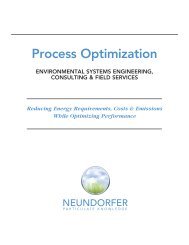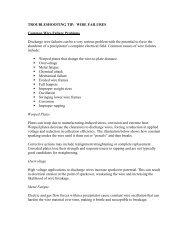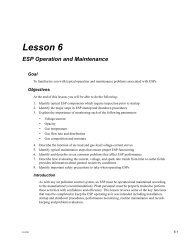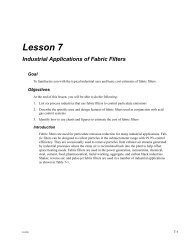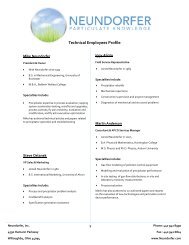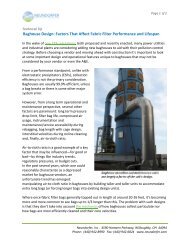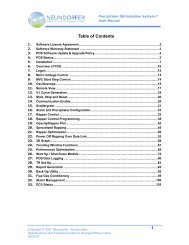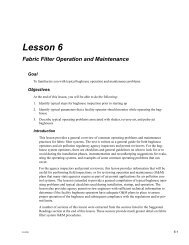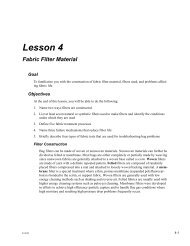Lesson 5 Fabric Filter Design Review
Lesson 5 Fabric Filter Design Review
Lesson 5 Fabric Filter Design Review
Create successful ePaper yourself
Turn your PDF publications into a flip-book with our unique Google optimized e-Paper software.
<strong>Fabric</strong> <strong>Filter</strong> <strong>Design</strong> <strong>Review</strong><br />
heavy dust concentrations are handled by using a baghouse in conjunction with a cyclone precleaner,<br />
instead of building a larger baghouse. Once the gas stream properties are known, the<br />
designers will be able to determine if the baghouse will require extras such as shell insulation,<br />
special bag treatments, or corrosion-proof coatings on structural components.<br />
<strong>Fabric</strong> construction design features are then chosen. The design engineers must determine<br />
the following: woven or felt filters, filter thickness, fiber size, fiber density, filter treatments<br />
such as napping, resin and heat setting, and special coatings. Once dust and gas stream properties<br />
have been determined, filter choice and special treatment of the filter can be properly<br />
made. For example, if the process exhaust from a coal-fired boiler is 400°F (204°C), with a<br />
fairly high sulfur oxide concentration, the best choice might be to go with woven glass bags<br />
that are coated with silicon graphite or other lubricating material such as Teflon.<br />
Along with choosing the filter type the designer must select the appropriate fiber type.Fibers<br />
typically used include cotton, nylon, fiberglass, Teflon, Nomex, Ryton, etc. The design should<br />
include a fiber choice dictated by any gas stream properties that would limit the life of the bag.<br />
(See <strong>Lesson</strong> 4 for typical fabrics and fibers used for bags.) For more information about fabric<br />
construction, see McKenna and Turner (1989).<br />
Proper air-to-cloth (A/C) ratio is the key parameter for proper design. As stated previously,<br />
reverse-air fabric filters have the lowest A/C ratios, then shakers, and pulse-jet baghouses have<br />
the highest. For more information about air-to-cloth ratios, see McKenna and Turner (1989).<br />
Once the bag material is selected, the bag cleaning methods must be properly matched with<br />
the chosen bags. The cost of the bag, filter construction, and the normal operating pressure<br />
drop across the baghouse help dictate which cleaning method is most appropriate. For example,<br />
if felted Nomex bags are chosen for gas stream conditions that are high in temperature and<br />
somewhat alkaline (see Table 4-1), pulse-jet cleaning would most likely be used.<br />
The ratio of filtering time to cleaning time is the measure of the percent of time the filters<br />
are performing. This general, “rule-of-thumb” ratio should be at least 10:1 or greater<br />
(McKenna and Furlong 1992). For example, if the bags need shaking for 2 minutes every 15<br />
minutes they are on-line, the baghouse should be enlarged to handle this heavy dust concentration<br />
from the process. If bags are cleaned too frequently, their life will be greatly reduced.<br />
Cleaning and filtering stress is very important to minimize bag failures. The amount of flexing<br />
and creasing to the fabric must be matched with the cleaning mechanism and the A/C ratio;<br />
reverse-air is the gentlest, shaking and pulse-jet place the most vigorous stress on the fabric.<br />
For example, it would probably not be advisable to use woven glass bags on a shaker baghouse.<br />
These bags would normally not last very long due to the great stress on them during the<br />
cleaning cycle. However, fiberglass bags are used on reverse-air baghouses that use shakeand-deflate<br />
cleaning. Also, some heavy woven glass bags (16 to 20 oz) are used on pulse-jet<br />
units (which also have high cleaning stress).<br />
Bag spacing is very important for good operation and ease of maintenance. Bag spacing<br />
affects the velocity at which the flue gas moves through the baghouse compartment. If bags<br />
are spaced too close together, the gas velocity would be high because there is very little area<br />
between the bags for the gas stream to pass through. Settling of dust particles during bag<br />
cleaning would become difficult at high velocities. Therefore, it is preferable to space bags far<br />
2.0-3/95 5-3



